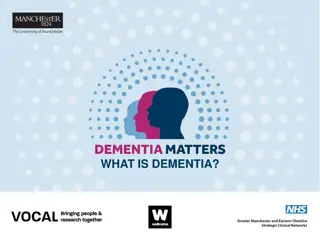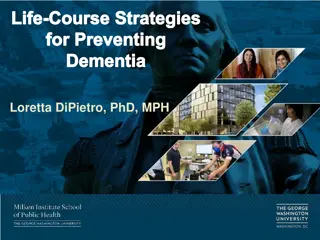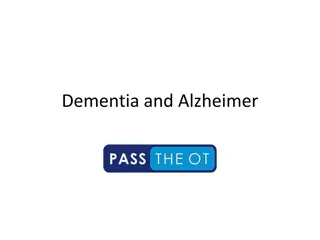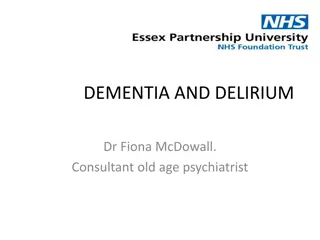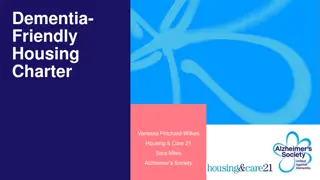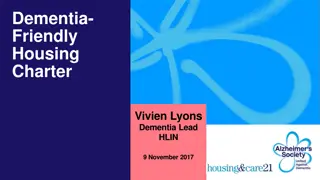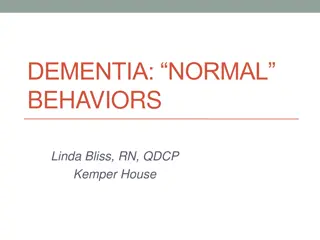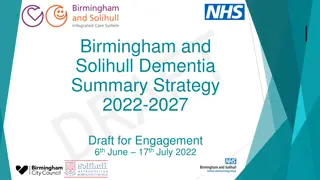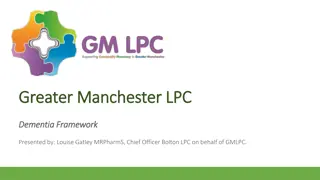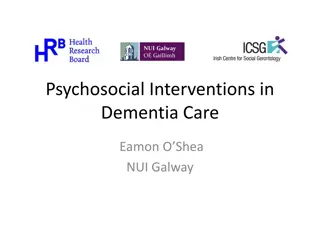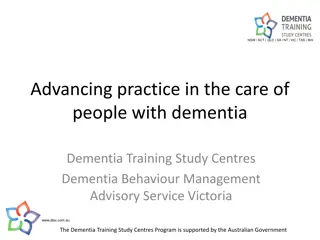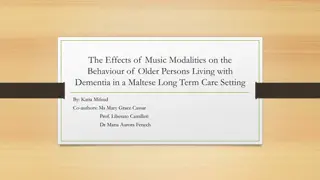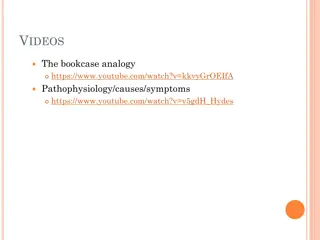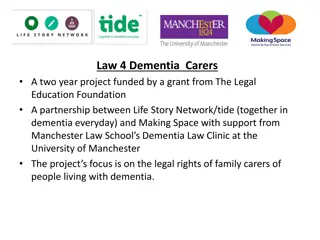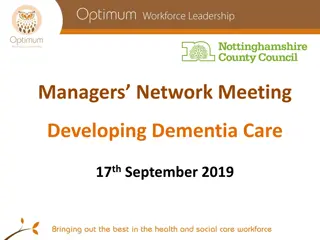Understanding Information Needs of People with Dementia in the Workplace
Workplace information needs, system design, and communication strategies for people with dementia are discussed, emphasizing the importance of supporting individuals with early onset dementia in the workplace. The role of employers, HR staff, and healthcare professionals in enhancing dementia awareness and providing necessary support is highlighted, along with the need for research and information science in dementia care.
Download Presentation

Please find below an Image/Link to download the presentation.
The content on the website is provided AS IS for your information and personal use only. It may not be sold, licensed, or shared on other websites without obtaining consent from the author. Download presentation by click this link. If you encounter any issues during the download, it is possible that the publisher has removed the file from their server.
E N D
Presentation Transcript
Understanding workplace information needs and system design needs of people with dementia Diane Pennington PhD FHEA FRSA Lecturer in Information Science @infogamerist / diane.pennington@strath.ac.uk
How do we communicate? (Evans, Robertson, & Candy, 2016, p. 808)
Dementia in the workplace People are living and working longer Early onset dementia (< 65) is underdiagnosed Many, like my father, are encouraged or even forced to retire (Alzheimer s Association, 2006) Work can help people with dementia maintain quality of life and see improvement in symptoms (Wilson, 2005; Robertson & Evans, 2015) Employers need to increase dementia awareness (McNamara, 2014) HR staff want more training (Cox & Pardasani, 2016) Employee health nurses should watch for symptoms (Lurati, 2014) Lack of research on dementia in the workplace and an agenda is needed (Ritchie et al. 2015) How do we support them?
The need for information science research in dementia care ASIS&T 2015 panel: How can information science contribute to Alzheimer s disease research? Very little research in information needs for dementia, although information is important for dementia care (Span et al., 2013; Clarke, Alexjuk, & Gibb, 2011) Needed for decision-making Needs change throughout the progression People with dementia, physicians, carers, have different needs Professional information may disrupt the biographical narrative that people with dementia value (p. 237) because it is too biomedical and not focused on the person/experience
Reconceptualising information for dementia research Information seeking for the system of people with and surrounding dementia is a constant state of being Bates (2005, p. 1036) Information 1 and Information 2 are associated with organization of matter and energy and meaning ascribed to them Organisation of language, understanding, and meaning becomes increasingly difficult and complex as dementia progresses
Dementia and other forms of information Words may not be used correctly, but are still used (Kotai-Ewers, 2000) Other methods of communication are better retained, such as songs and their lyrics (Brotons, 2000) Bodily information or changes in cognitive and physical function is important in health information literacy (Yates, 2015) What information types best reflect cognitive, physical, emotional information needs? How can we best understand what (technology) systems will support them in the workplace?
Non-text formats for eliciting information from and communicating with people with dementia Involving people with dementia at all stages of system development is essential (Span et al., 2013) Like many of us, information that is provided as a lot of text may be hard to take on board so information may be better communicated by being shared verbally as well, or presented in non-text formats such as a video clip on DVD or through pictures (Clarke, Alexjuk, & Gibb, 2011, p. 239).
Improvement in communication and health through non-text methods Movement, sound, visual art, performance, music (Aldridge, 2000; Beard, 2011) (Riley, Alm, & Newell, 2009)
(Non-text) active participant engagement Video recordings of observation Video recordings of ethnomethodology to listen to dialogue but also observe non-verbal communication Photovoice: participants take pictures on the research topic and are then interviewed on the photos Evans, Robertson, and Candy, 2016: workplace return after an early onset diagnosis 4 areas: dementia impact, family impact, work experience, new friends Photo elicitation: Discuss content, meaning of pictures in an interview Reflexive photography: Photo and interview used to gather reactions Photo-survey: Record environment with pictures during research Photo-driving: Show pictures to participant of themselves during the interview to show their own behaviour
Analysis methods Theoretical framework Type of document to analyse will determine what can be analysed What has been elicited? Images, videos, music, speech? Scope/boundaries: what will be analysed? Visual analysis will exclude accompanying text Photographic document approach Unit of analysis The image? The collection?
Methods for analysing non-text documents created or gathered from people with dementia (Pennington, 2016) Compositional interpretation Qualitative and quantitative content analysis Document analysis Videography Musical analysis Cultural studies Visual sociology/anthropology Iconography/iconology Visual discourse analysis Visual social semiotics Multimodal research/ethnography
An example - compositional interpretation: appearance of an image on its own Content, colour, hue, spatial organisation, film editing, affective expression (Evans, Robertson, & Candy, p. 809)
The future of understanding workplace information system needs People with dementia have different notions of understanding their work and therefore struggle with communicating what information might help them perform work New research methods are needed to elicit information and design needs from marginalised groups in the workplace This can lead to 3 proposed agenda steps refine (non-text?) methods for elicitation have conversations (in whatever form) with affected workers Develop better designed workplace supports and services
A great story We ought to write a story like this You could go on and on for years We ll make up a story The whole set You re going to have a great story What a pity I didn t write it up all over What is the hard part if you don t remember them What is the pity of it if you don t remember them It s a strange world isn t it? - Irene (Kotai-Ewers, 2000, p. 63)
My working model of a dementia ontology, with a PLWD at the centre


